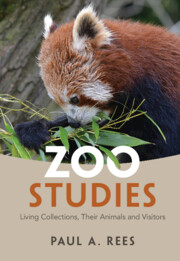Book contents
- Zoo Studies
- Zoo Studies
- Copyright page
- Dedication
- Contents
- Preface
- Acknowledgements
- Abbreviations
- 1 Zoos and Research
- 2 Defining Zoos, Their Culture and Visitors
- 3 Zoos and Education
- 4 Anthrozoology and Visitor Behaviour
- 5 Zoo Organisation and Regulation
- 6 Ethics, Zoos and Public Attitudes
- 7 The Contribution of Zoos to Zoology
- 8 Animals and Their Enclosures
- 9 Animal Welfare
- 10 Enrichment and Training
- 11 Conservation Breeding, Reproduction and Genetics
- 12 Restoration, Rehabilitation and In-Situ Conservation
- 13 Animal Nutrition and Conservation Medicine
- 14 The Past and Future of Zoos
- Bibliography
- References
- Subject Index
- Animal Species Index
4 - Anthrozoology and Visitor Behaviour
Published online by Cambridge University Press: 12 May 2023
- Zoo Studies
- Zoo Studies
- Copyright page
- Dedication
- Contents
- Preface
- Acknowledgements
- Abbreviations
- 1 Zoos and Research
- 2 Defining Zoos, Their Culture and Visitors
- 3 Zoos and Education
- 4 Anthrozoology and Visitor Behaviour
- 5 Zoo Organisation and Regulation
- 6 Ethics, Zoos and Public Attitudes
- 7 The Contribution of Zoos to Zoology
- 8 Animals and Their Enclosures
- 9 Animal Welfare
- 10 Enrichment and Training
- 11 Conservation Breeding, Reproduction and Genetics
- 12 Restoration, Rehabilitation and In-Situ Conservation
- 13 Animal Nutrition and Conservation Medicine
- 14 The Past and Future of Zoos
- Bibliography
- References
- Subject Index
- Animal Species Index
Summary
This chapter examines animal–human relationships in zoos and the behaviour of visitors. Keeper–animal relationships are important to the welfare of both, and keepers are important sources of information for researchers. Some animals pose a health and safety risk to keepers, veterinarians and visitors as a result of accidents or disease transmission. The behaviour of visitors in zoos has become an important area of academic and practical interest. Researchers measure dwell time as an indicator of the extent to which an exhibit holds the attention of a visitor. It is important to understand how visitors know their position in a zoo (orientation), how they find their way (wayfinding) and how they move around in a zoo (circulation) because these factors can affect their satisfaction with their visit and influence animal welfare.
- Type
- Chapter
- Information
- Zoo StudiesLiving Collections, Their Animals and Visitors, pp. 71 - 96Publisher: Cambridge University PressPrint publication year: 2023

